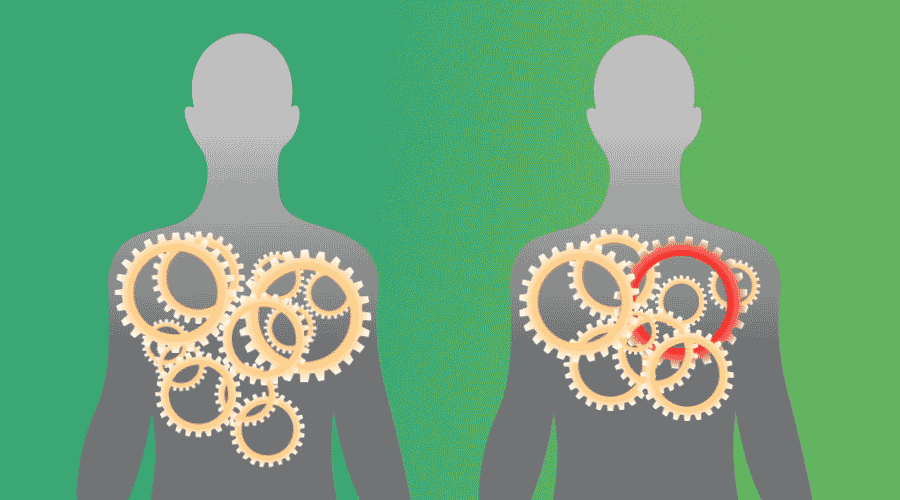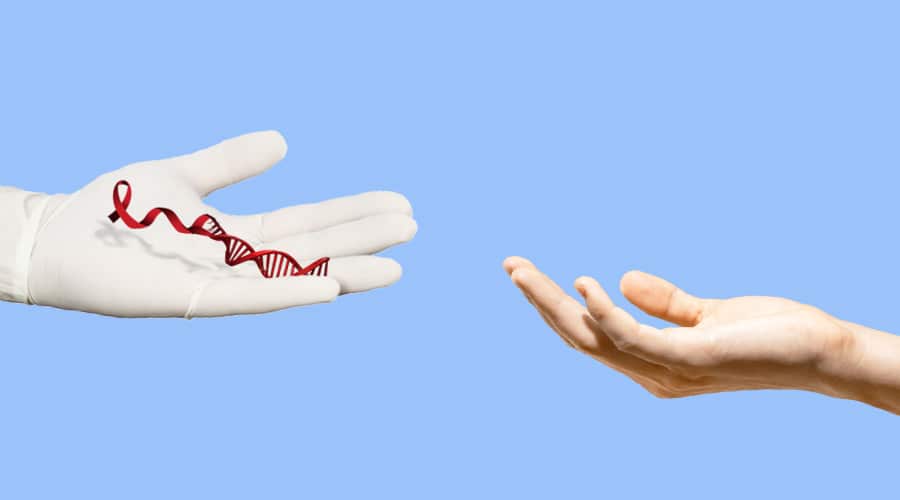How to Design a Gene Therapy to Target Inherited Diseases


Contributing Author Luke Williams, Sales and Marketing
The human genome contains approximately 20,000 protein-coding genes. When read, these genes tell a cell how to make a specific protein, which can then be used to perform a cellular process. Variations on any of these genes can have effects ranging from eye color to lethal disorders. Conventional medicines used to treat these genetic diseases typically only work for a few hours before needing to be readministered. These regularly administered pills, infusions, or other interventions can manage the symptoms of these lifelong conditions, but cannot address the root cause of the disease. However, with gene therapy, we can provide cells the genetic instructions they need to actually correct the problem. So how do scientists understand how the body works and write genetic code to create these long-term solutions?
What do genetic diseases look like?
Since the age of Mendel, scientists have been fascinated by patterns of inheritance. Beyond the normal variations that make us unique, abnormalities in the DNA a person inherits can cause:
- Cystic Fibrosis
- Huntington’s Disease
- Duchenne Muscular Dystrophy
- Sickle Cell Anemia
- Hemophilia
- Thalassemia
These disorders are with a person from birth; some are managed through medications or infusions, some are completely unaddressable, and others (such as Hemophilia A and B) have even been cured using gene therapy. In the following sections, we’ll talk about the current standard of care for conditions like these, and the genetic techniques that scientists are using to revolutionize the way these disorders are treated.
How are genetic diseases managed today?
The root cause of a genetic disorder is the pathogenic gene. Cells follow instructions written in DNA to produce a protein, and when the instructions they inherit cause them to produce a protein product that doesn’t mesh with the rest of the body, it can cascade into higher-order problems. To illustrate the diversity of these conditions, and how they are maintained, consider these examples:
- For disorders like Cystic Fibrosis, which causes the buildup of abnormally thick mucus in the respiratory organs, physical intervention to help clear the airways can help manage the symptoms.
- For disorders like Phenylketonuria (PKU), where Phenylalanine in the diet can build to toxic levels and cause irreversible damage, special consideration to diet and environment, along with supplemental enzymes can help prevent harm.
- For conditions like Mucopolysaccharidosis (MPS), it is possible to identify the missing/incorrect protein that causes the problem and produce the correct form of it outside the body. Next, infuse the protein into someone who isn’t making the right protein in the right amounts.
- For conditions like Huntington’s disease, there is no known cure or treatment which can alter the course of the condition. In cases like this, medications can help ease symptoms for a time, but the root cause of the disease is not possible to address.
The conditions listed above show how the standard of care differs based on the unique needs of patients with inherited disorders. While the symptoms may vary, these conditions are united by their root cause: the DNA that the patient inherited. The genetic nature of these disorders makes them natural targets for gene therapy, so how can scientists write the therapeutic DNA necessary to correct the disease?
How to write a therapeutic gene
At first glance, it may seem impossibly complicated to create a gene. The good news is that for most diseases, a healthy research base gives scientists a plenty of information to work with:
- Which chromosome is the gene on, and what is its position on that chromosome?
- What is the transcript of the gene? (The genetic code itself)
- If the gene tells the cell to make a protein, what does that protein look like?
- What’s the difference between a functional gene and a pathogenic one?
Depending on the features of the gene, designing a therapeutic may be as simple as copying a functional transcript from a database and giving it to the cells that need it, with minimal or no changes; this is referred to as gene replacement therapy. Scientists may also take more creative approaches to solve disorders which are caused by more complex genetic dysregulation.
How to deliver a gene therapy
A therapeutic gene is only useful if the right cells read it, so delivery is critically important. There are multiple ways to insert a gene into a cell, but the most widely used in gene therapy is a protein shell called a viral vector. Viruses use these shells as one-way delivery mechanisms to get from cell A to cell B – they’re like vehicles for genetic information. By swapping out the self-replicating, pathogenic viral genome for a therapeutic gene, scientists can precisely target their therapeutic DNA directly to the nucleus of a specific cell type. The remarkable precision of these viral vectors allows cell-type-specific targeting like:
- Helper T cells
- Liver Cells
- Sensory Neurons
Each cell type only reads specific genes. For example, your muscle cells only read the genes necessary to build functional fibers while another cell type such as one in your stomach may only read the genes necessary to produce high strength acid. Since cells tend to only read the genes encompassing their specialized roles, targeting a gene therapy to a cell type that will actually read it is essential for its function. Additionally, gene therapies are expensive to produce, so delivering them accurately minimizes waste and helps control cost. If done correctly, delivering the right gene to the right cells can solve the root cause of the disease and eliminate the need for external medication.
How does the immune system react to gene therapies?
Every person’s immune system is calibrated to their individual body, which is why it can react to a wide diversity of pathogens and also why it may reject transplanted organs. Since the immune system can react to the addition of new genes, the gene therapies on the market today strategically avoid recognition and rejection using two main strategies. Certain parts of the body, like the eyes and the spinal column, are not heavily patrolled by the immune system, making them good starting places for gene therapies. In fact, the first gene therapy approved for use in the United States, Luxturna, edits cells in the eyes to correct a form of blindness. About a year and a half later, Zolgensma edited the cells in the spinal column to correct Spinal Muscular Atrophy, a previously unaddressable lethal genetic deficiency.
Gene therapists may also avoid the immune system by incorporating elements like these into their approach:
- Introduce a protein that is similar to the existing copy in the body. There will be fewer differences for the immune system to pick up on.
- Use gene therapy to rewrite proteins that are secreted by cells. Once the protein is outside the cell, the evidence is gone and the cell may slip past the immune system’s surveillance.
- Tell the cell to make special RNA instead of teaching the cell how to make new proteins. Since the immune system patrols the body looking for protein fragments, as long as no new proteins are detected, the immune system may leave modified cells alone.
A great example of this is our Phenylketonuria (PKU) program, which incorporates all of these elements into the therapeutic approach. The therapeutic gene teaches the cell how to make the correct version of an essential enzyme, which may be a minimal correction to the inherited version. This protein is produced, packaged into a complex of other proteins, and secreted from the cell. The gene therapy also teaches the cell how to make RNAs that can intercept and effectively block the mRNA from the inherited pathogenic gene. It’s a bit like how noise-canceling headphones selectively block the messages you don’t want to hear. Learn more about our approach to PKU here.
The future of gene therapy treatments for inherited diseases
The human body is a complex symphony of hundreds of cell types reading tens of thousands of distinct genes that encode various proteins which interact to perform cellular functions. If any one of those genes (and thus, its corresponding protein) is non-functional, it can result in the malfunction of a cellular function and lead to a diverse array of symptoms. By understanding the root cause of inherited genetic diseases, scientists can use modern biological tools to write and deliver disease-correcting therapeutic DNA. Getting their gene therapy to mesh well with the immune system is a challenge, but strategies exist today to ensure that cells which receive gene therapies live long, productive lives without being killed by the immune system.
Today, scientists are striving to design curative gene therapies for inherited conditions. Looking forward, new technologies and therapeutic strategies may put even more of these inherited disorders within range. The direct-acting nature of gene therapy on genetic conditions makes it a logical choice for intervention. With scientific creativity as the only limitation to addressing thousands of diseases, which, until now, modern medicine has had no answer to. At American Gene Technologies®, we live by the words “creativity cures.” To everyone who agrees with the notion, we encourage you to follow us, apply to our open positions, and above all, maximize your creativity.





